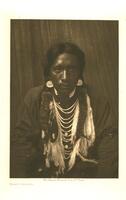2 Items in this Learning Collection
Collection Object
Copyright
All Rights Reserved
()
Shirt—Kalispel
Accession Number
1997/1.154
Title
Shirt—Kalispel
Artist(s)
Edward S. Curtis
Artist Nationality
American (North American)
Object Creation Date
1910
Medium & Support
photogravure on paper
Dimensions
12 1/2 in x 9 7/16 in (31.75 cm x 23.97 cm);14 3/8 in x 19 7/16 in (36.51 cm x 49.37 cm)
Credit Line
Gift of Stephen M. Taylor
Subject matter
This image of a subject from the Kalispel tribe in Northeastern Washington is from The North American Indian (1907 - 1930), a twenty-volume series created by Edward Curtis in order to document the lives of Native Americans in diverse regions of the Western United States. This limited edition volume was financially supported by J.P. Morgan, and promoted by Theodore Roosevelt. The resulting works have been criticized and celebrated for their portrayal of Native American life. Curtis often included anachronous props and clothing and presented rituals that had not been performed in years in order to support an idealized and romantic reading of a “vanishing race.”
Physical Description
A single-sitter portrait, with the subject wearing two braids and a decorated shirt. The subject wears large circular earrings and multiple strands of beadwork, which contrast against the dark shirt and backdrop.
Primary Object Classification
Photograph
Collection Area
Photography
Rights
If you are interested in using an image for a publication, please visit http://umma.umich.edu/request-image for more information and to fill out the online Image Rights and Reproductions Request Form.
Keywords
Kalispel
Native American
Portraits
braids (hairstyle)
costume (mode of fashion)
costumes
half-length
modern and contemporary art
seated
single-sitter portraits
1997/1.154
Title
Shirt—Kalispel
Artist(s)
Edward S. Curtis
Artist Nationality
American (North American)
Object Creation Date
1910
Medium & Support
photogravure on paper
Dimensions
12 1/2 in x 9 7/16 in (31.75 cm x 23.97 cm);14 3/8 in x 19 7/16 in (36.51 cm x 49.37 cm)
Credit Line
Gift of Stephen M. Taylor
Subject matter
This image of a subject from the Kalispel tribe in Northeastern Washington is from The North American Indian (1907 - 1930), a twenty-volume series created by Edward Curtis in order to document the lives of Native Americans in diverse regions of the Western United States. This limited edition volume was financially supported by J.P. Morgan, and promoted by Theodore Roosevelt. The resulting works have been criticized and celebrated for their portrayal of Native American life. Curtis often included anachronous props and clothing and presented rituals that had not been performed in years in order to support an idealized and romantic reading of a “vanishing race.”
Physical Description
A single-sitter portrait, with the subject wearing two braids and a decorated shirt. The subject wears large circular earrings and multiple strands of beadwork, which contrast against the dark shirt and backdrop.
Primary Object Classification
Photograph
Collection Area
Photography
Rights
If you are interested in using an image for a publication, please visit http://umma.umich.edu/request-image for more information and to fill out the online Image Rights and Reproductions Request Form.
Keywords
Kalispel
Native American
Portraits
braids (hairstyle)
costume (mode of fashion)
costumes
half-length
modern and contemporary art
seated
single-sitter portraits

